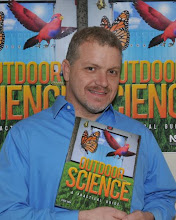.jpg) During my speaking engagements and conference presentations this fall, I have been talking about simple ways that teachers can bring a bit of the outdoors into classrooms -making science come to life for students. As the weather gets cooler at this time of year, it's often easier to bring something in rather than taking students outdoors. Either way, the learning can be enriched when students get their hands and eyes directly on something in or from nature. One of the lessons in Bringing Outdoor Science In focuses on making a model of a barrier island. Following the desvastation of Hurricane Sandy along the northeast coast of the U.S., this is certainly a timely lesson. As a child growing up along Georgia's Atlantic coast, I learned early the importance of barrier islands to the mainland. When we see the sand from an entire beachfront moved a couple of blocks inland, it is probably confirmation that development should have never been allowed so close to the beach. Helping students understand this concept using my lesson takes just a bit of sand, a plastic shoebox, and some natural materials like sticks or branches to simulate trees and vegetation. Add some water to model the ocean waves coming in and it doesn't take long to model how a barrier island can protect a larger body of land.
During my speaking engagements and conference presentations this fall, I have been talking about simple ways that teachers can bring a bit of the outdoors into classrooms -making science come to life for students. As the weather gets cooler at this time of year, it's often easier to bring something in rather than taking students outdoors. Either way, the learning can be enriched when students get their hands and eyes directly on something in or from nature. One of the lessons in Bringing Outdoor Science In focuses on making a model of a barrier island. Following the desvastation of Hurricane Sandy along the northeast coast of the U.S., this is certainly a timely lesson. As a child growing up along Georgia's Atlantic coast, I learned early the importance of barrier islands to the mainland. When we see the sand from an entire beachfront moved a couple of blocks inland, it is probably confirmation that development should have never been allowed so close to the beach. Helping students understand this concept using my lesson takes just a bit of sand, a plastic shoebox, and some natural materials like sticks or branches to simulate trees and vegetation. Add some water to model the ocean waves coming in and it doesn't take long to model how a barrier island can protect a larger body of land.
Whether it's sand & water that teachers use, or other outdoor items such as acorns, pine cones, rocks, or soil, bringing in a little bit of the outdoors can provide a memorable hands on, minds on experience for students. Check out the free chapter of Bringing Outdoor Science In on www.nsta.org .
The free chapter, "Rocks & Soils" has the barrier island lesson and many more.
So while the weather is cooler, bring the outdoors in for kids...and on a sunny day, take science outdoors!
